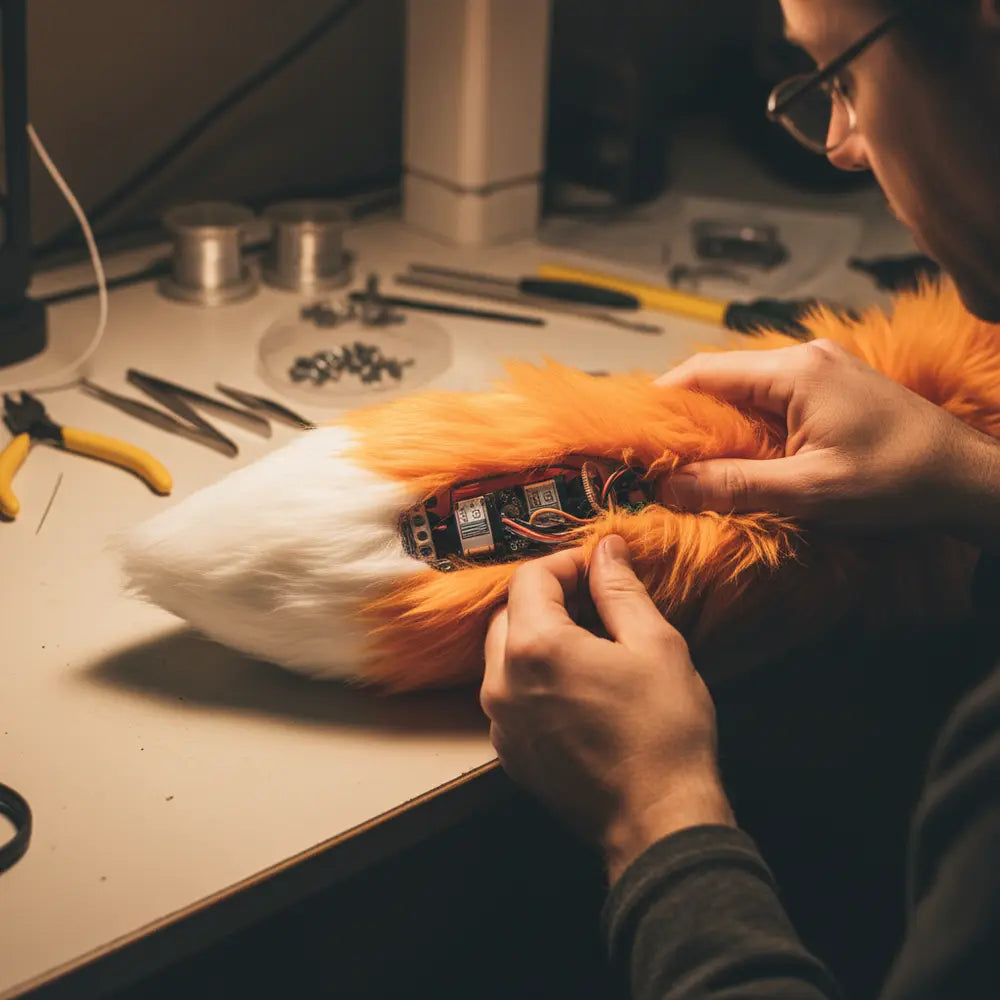
DIY vs Buy: Best Moving Fox Tails Guide
Imagine walking into a convention, and with every step, your lifelike fox tail swishes and curls with a mind of its own. It's the kind of detail that turns heads and elevates a great costume into an unforgettable one. But this brings you to a critical crossroads: should you build this amazing accessory yourself or buy one ready-made?
This is the ultimate dilemma for any aspiring maker or serious cosplayer. The DIY path promises customization and savings, but it's lined with technical challenges. Buying a pre-made tail offers instant gratification and professional quality, but it comes with a significant price tag.
Quick Quiz: Should You DIY or Buy?
Answer one question to get our recommendation!
What sounds more exciting to you?
This guide is here to help you decide. We'll break down real-world costs, time investment, and the skills needed for a DIY animatronic tail tutorial. We'll also explore the best cosplay animatronic tails of 2025 available for purchase. You'll see case studies of both a cosplayer who built their own tail and one who bought, giving you a clear picture of each experience.
Let’s start by understanding what makes a wearable animatronic tail truly realistic and captivating.
What Makes a Tail Truly Realistic?
Ever wonder what separates a good tail from a truly great one that seems alive? This section breaks down the three core elements of realism: movement, comfort, and durability, so you can spot quality whether you're building or buying.
The magic of a realistic moving fox tail isn't just that it moves—it's *how* it moves. The highest-quality tails have fluid, organic motions. They can sway gently as you walk, flick with excitement, or curl curiously. This is a world away from a tail that just swings back and forth like a robotic pendulum.
Achieving this naturalism often involves multiple servos or a clever mechanical design that allows for complex, pre-programmed or remote-controlled sequences. A tail that only moves side-to-side can look stiff, while one with an up-and-down or curling motion adds a significant layer of lifelike expression.
Weight and comfort are just as critical. An animatronic tail houses motors, batteries, and a control board. If poorly designed, it can feel like a lead weight pulling on your costume and lower back. A well-engineered tail distributes this weight across a sturdy, comfortable harness, making it wearable for an entire day at a convention.
Finally, durability is a key component of realism. A tail that breaks down after an hour isn't just inconvenient; it shatters the illusion. The internal mechanics must be robust enough to handle bumps, snags, and hours of continuous motion. The fur covering should also be high-quality, resisting shedding and maintaining its appearance through repeated use.

DIY Animatronic Tail Tutorial Overview
Thinking about building a tail yourself but feel overwhelmed by the technical details? Here, we'll demystify the process by outlining the essential components, tools, and skills you'll need to bring your own creation to life.
Embarking on a DIY animatronic tail tutorial is a rewarding project for any maker. At its core, a wearable robotic tail for costumes is a fascinating blend of electronics, mechanics, and artistry. Understanding the fundamental parts is the first step on this creative journey.
Basic Components
The heart of your tail will be its mechanical and electronic systems. Here’s what you’ll typically need:
- Servos: These are the small motors that create movement. For a simple wagging tail, one servo might suffice. For more complex curling or twitching motions, you might use two or three linked together.
- Microcontroller: This is the brain of your tail. An Arduino or a similar board is a popular choice, as it's programmable and can control the servos to create specific movement patterns.
- Power Source: A rechargeable battery pack (like a USB power bank) is essential to power the microcontroller and servos. You'll need to calculate your power needs to ensure it lasts a full day.
- Structural Skeleton: Many DIY builders use a 3D-printed or hand-shaped plastic spine. This houses the electronics and creates the segments that allow the tail to bend and flex realistically.
- Fur Covering: The final touch is a high-quality faux fur "sock" that slips over the mechanical skeleton, hiding the inner workings and completing the illusion.
Tools and Skills Required
While you don't need to be a robotics engineer, some foundational skills are necessary. You will likely need a soldering iron to connect wires, a 3D printer for the spine (or the ability to order prints online), and basic hand tools. A little bit of coding knowledge for the Arduino is a huge plus, though many tutorials provide pre-written code you can adapt.
A case study from the maker community showed a builder creating a functional, wagging fox cosplay tail with movement for under $100. They sourced affordable servos online, used a basic Arduino Nano, and 3D printed a segmented spine from a free file. It’s a testament to how resourcefulness can make this project accessible.
Pros and Cons of DIY Building
Is the personal satisfaction of creating your own custom tail worth the long nights of soldering and coding? This section weighs the true costs and benefits of the DIY path to help you decide if it's the right challenge for you.
Building your own programmable robotic cosplay tail is a tempting prospect. You get ultimate control over the final product and the pride of saying, "I made this." However, it's important to go in with a clear understanding of both the incredible advantages and the potential pitfalls.
The Pros of DIY
- Unmatched Customization: The biggest advantage is total freedom. You can design the tail's exact length, shape, and movement patterns. Want a nine-tailed fox? Or a tail that syncs with music? With DIY, your imagination is the only limit.
- Significant Cost Savings: If you already have the tools, building a tail can be much cheaper than buying one. The raw components—servos, microcontroller, fur—can often be purchased for a fraction of the price of a commercial product.
- Valuable Skill Development: This is more than just a cosplay project; it's a crash course in electronics, mechanics, and programming. The skills you learn are transferable to countless other maker projects, from robotics to home automation.
The Cons of DIY
- Steep Learning Curve: If you're new to electronics or coding, the initial learning curve can be steep. Debugging why a servo is jittering or why your code isn't uploading can be a frustrating experience that consumes a lot of time.
- Significant Time Investment: Don't underestimate the hours involved. Researching, ordering parts, printing, assembling, coding, and troubleshooting can easily take 40-60 hours or more for a first-time builder. This isn't a weekend project.
- Risk of Failure or Low Quality: There's always a chance that the final product won't work as expected. The movement might be clunky, the wiring might be unreliable, or the construction might not be durable enough for a convention floor.
For those ready to take on the challenge, the journey is half the fun. A phenomenal starting point is a detailed walkthrough. For a deeper dive with full schematics, wiring diagrams, and pro tips not found in most videos, the go-to resource is our DIY Animatronic Cosplay Tail Tutorial (Step-by-Step Guide).
Buying a Ready-Made Animatronic Tail in 2025
Ready to skip the workshop and get straight to the convention floor with a flawless tail? This section explores the world of pre-made animatronic tails, covering the types available, what you can expect to pay, and where to find the best ones.
If your primary goal is a stunning, reliable, and convention-ready accessory without the headache of building it, then buying is your best bet. The market for the best cosplay animatronic tails in 2025 has matured, offering a range of options that cater to different needs and budgets. These tails are crafted by specialists who have perfected the art of silent motors and lifelike motion.

Types of Tails Available
Ready-made animatronic tails generally fall into a few categories:
- Basic Auto-Wag Tails: These are the entry-point, often featuring a simple, continuous side-to-side wagging motion. They are a great way to add life to a costume without a huge investment.
- Remote Control Tails: A step up, these tails come with a small, concealable remote that allows you to trigger different movements on command. You can make the tail twitch, wag, or stand alert, adding a layer of interactive performance to your cosplay.
- Programmable and App-Controlled Tails: The highest tier of custom made realistic moving tails. These often connect to a smartphone app, allowing you to create and save complex movement sequences. Some even have modes that react to motion or sound.
Poll: Which Tail Type Do You Prefer?
Price Ranges and Where to Buy
The cost of a wearable animatronic tail varies widely based on its complexity and quality.
- Entry-Level ($200 - $350): In this range, you'll find reliable auto-wag tails with good quality fur and construction.
- Mid-Range ($350 - $600): This is the sweet spot for many serious cosplayers, offering remote-controlled movements and more realistic, quieter mechanics. For instance, the Dynamic Red Fox Moving Tail for Cosplay & Fashion is a leading example in this category, known for its silent motor and fluid, dynamic motion.
- High-End ($600+): These are the fully programmable, app-controlled models often made by boutique creators. They offer the most realistic and customizable movements available on the market.
Specialized online shops and marketplaces like Etsy are the primary places to find these creations. Look for sellers with strong reviews, clear video demonstrations of the tail in action, and good customer support. This technology is closely related to other kinetic accessories. If you're curious about how these expressive gadgets work, you can explore our detailed article explaining what moving cat ears are and the science behind them.
Pros and Cons of Buying
Is the convenience of a professionally made tail worth the higher price tag? We're breaking down the key advantages and potential drawbacks of buying a ready-to-wear animatronic tail to see if it aligns with your cosplay goals and budget.
Opting for a store-bought realistic animatronic tail for Halloween or a major convention offers peace of mind and professional polish. But that convenience comes at a cost. Let's weigh the factors to see if it’s the right choice for you.
The Pros of Buying
- Instant Gratification & Reliability: The single biggest benefit is that it works perfectly right out of the box. There's no troubleshooting, no coding, and no assembly. You can focus on the rest of your costume, confident that your tail is convention-ready and reliable.
- Professional-Grade Movement and Quality: Companies and artists specializing in these tails have spent years refining their designs. You're paying for silent motors, fluid and complex movement patterns, and durable construction designed to withstand the rigors of a convention.
- Customer Support and Warranty: Reputable sellers often provide customer support and may offer warranties or repair services. If something goes wrong, you have someone to turn to, which is a safety net you don't have with a DIY project.
The Cons of Buying
- Significantly Higher Cost: A professionally made tail is an investment. The price can be three to five times higher than the cost of raw materials for a DIY build, which can be a major barrier for budget-conscious cosplayers.
- Limited Customization: While some sellers offer choices in fur color and length, you are ultimately buying a pre-designed product. You won't be able to create a one-of-a-kind shape or unique movement pattern that perfectly matches a niche character design.
- Less Personal Connection: For some, the journey of making is as important as the final product. Buying a tail means you miss out on the pride and unique story that comes from building your own piece of wearable technology. A cosplayer who purchased a high-end tail noted, "I paid for the peace of mind. I knew it would look perfect and last all weekend, which let me focus on performing my character."
DIY vs Buy: Cost & Effort Breakdown
Let's get down to the numbers. Where does your money and time truly go? This head-to-head comparison breaks down the realistic costs and time investment for both building and buying, helping you make a financially and practically sound decision.
The choice between DIY and buying often comes down to a trade-off between your two most valuable resources: time and money. Here’s a realistic look at how they stack up, so you can decide which currency you'd rather spend.

Cost Comparison
A common misconception is that DIY is always drastically cheaper. While the raw material cost is lower, you must factor in tools and potential mistakes. A high-end purchased tail includes the cost of labor, R&D, and support.
| Feature | DIY Animatronic Tail | Buying a Ready-Made Tail |
|---|---|---|
| Estimated Cost | $90 - $200+ | $300 - $600+ |
| Components | Servos, microcontroller, batteries, wires | All-inclusive, ready-to-wear product |
| Tool Investment | Soldering iron, 3D printer (or service) | None |
| "Hidden" Costs | Failed parts, shipping for components | Premium for professional polish & R&D |
| Best Value For | Makers who want customization & a project | Cosplayers who value time & reliability |
As the table shows, a DIY project can save you over 50%, but that doesn't account for your time.
Time Investment
This is where the two paths diverge most dramatically.
- DIY Time: For a first-timer, expect 40-80 hours spread across several weeks. This includes research, waiting for parts, assembly, coding, and inevitable troubleshooting.
- Buying Time: The time investment here is minimal—perhaps 1-2 hours of research to choose the right model and seller, plus shipping time.
The Verdict: Which is Right for You?
Your answer depends entirely on your personality and priorities.
- Choose DIY if: You are a hobbyist who enjoys the process of making. Your budget is tight, you want a fully unique tail, and you view the time spent as a fun learning experience.
- Choose to Buy if: You are on a deadline for an event, or your skills lie more in sewing and performance than electronics. For you, the tail is a crucial part of a larger project, and you need it to work perfectly without any fuss. For this cosplayer, the investment in a product like the Dynamic Red Fox Moving Tail is a clear winner.
Tips for Choosing the Right Option
Feeling stuck between the thrill of a DIY project and the ease of a purchased tail? This section provides a simple framework to help you make the final call by assessing your budget, skills, and the specific goals for your costume.
Making the right decision is about self-awareness. By honestly evaluating your resources and goals, you can choose the path that leads to success and satisfaction instead of frustration.
1. Honestly Assess Your Budget
Look beyond the sticker price. If you choose DIY, do you have money set aside for tools you might need to buy, like a good soldering iron? Can you afford to replace a servo if you accidentally burn it out? If your total budget for the entire costume is tight, the upfront savings of DIY might be the deciding factor.
2. Realistically Evaluate Your Skillset and Patience
Be honest about your technical comfort level. Have you ever worked with electronics or written a line of code? If not, are you genuinely excited to learn? The DIY path is filled with small failures that lead to eventual success. If you know that troubleshooting technical issues frustrates you, buying a polished product will be a much more enjoyable experience.
3. Consider Your Event Goals
What is the primary purpose of this costume? If it’s for a one-night realistic animatronic tail for Halloween, a simpler, less durable DIY build might be perfectly adequate. However, if this is your main cosplay for a three-day convention, durability and reliability become paramount. A failed tail on day one can be a huge disappointment.
Consider the growing trend of using these accessories beyond conventions, as detailed in our article on why fox tails are trending in everyday fashion and self-expression. If you plan to wear it often, investing in a professionally made tail with a robust build may offer better long-term value. A first-time cosplayer might choose to buy a tail for their first big event to ensure a positive experience, then tackle a DIY project later once they're more comfortable in the scene.
Resources & Next Steps
Ready to take the plunge? Whether you're firing up your soldering iron or pulling out your credit card, this section provides the direct links and communities you need to get started on your animatronic tail journey.
Now that you have a clearer idea of which path is right for you, it's time to take action. Here are the essential resources to guide your next steps.
For the DIY Builder
Your journey starts with knowledge. You need a comprehensive guide that goes beyond a simple video and gives you the technical details to succeed.
- The Ultimate Tutorial: For a complete, step-by-step guide with wiring diagrams, materials lists, and maker-tested advice, the definitive resource is our DIY Animatronic Cosplay Tail Tutorial. It's designed to take you from concept to a fully functional wearable robotic tail for costumes.
- Community Support: When you hit a snag, you'll need help. The communities at r/cosplayprops on Reddit and the Adafruit Forums are full of experienced makers willing to help you troubleshoot code or offer mechanical advice.
For the Smart Shopper
Finding a high-quality, pre-made tail means going to the experts who have perfected their craft. You want a product known for its performance and durability.
- Top-Tier Recommendation: If you're looking for a balance of exceptional quality, silent operation, and breathtakingly realistic movement, the consensus among serious cosplayers points to the Dynamic Red Fox Moving Tail for Cosplay & Fashion. It represents the best of what's available for those who value a premium, reliable product.
- Marketplaces to Explore: Browse shops on Etsy by searching for "custom made realistic moving tails" or "cosplay tails that move automatically." Always check video reviews and seller ratings before making a purchase to ensure you're getting the quality you expect.
No matter which path you choose, you are joining an incredible community of creators and performers who bring fantasy to life.
Conclusion
The decision to build or buy a realistic moving fox tail is a personal one, balancing your passion for making against the practicality of your budget and timeline. There is no single "right" answer, only the answer that is right for you.
If you thrive on creative challenges, have a knack for technology, and want a tail that is 100% unique, the DIY path offers immense satisfaction and skill-building. It’s an adventure in itself. On the other hand, if your priority is a flawless, reliable, and performance-ready accessory that allows you to focus on your character, investing in a professionally crafted tail is a smart choice that guarantees quality and peace of mind.
Reflect on your budget, your skills, and what you want to achieve with your costume. Whether you choose to be the maker or the performer, the end result is the same: adding a touch of animatronic magic to your cosplay.
Ready to find your perfect tail? Explore our curated list of 2025's best animatronic cosplay tails.
Frequently Asked Questions
1. How heavy is a typical animatronic tail?
A well-designed animatronic tail, whether DIY or purchased, typically weighs between 1.5 to 3 pounds (0.7 to 1.4 kg). The weight is managed by a sturdy harness system worn under your costume, which distributes the load across your hips or back to ensure it's comfortable to wear for several hours.
2. How long do the batteries last in a battery-powered costume tail?
Battery life depends on the size of the battery pack and the intensity of the tail's movement. Most tails are designed to last a full convention day (6-8 hours) of intermittent movement on a single charge from a standard USB power bank (10,000 mAh is a common choice).
3. Do I need to know how to code to make a DIY animatronic tail?
Not necessarily. Many online tutorials and guides, including our comprehensive DIY Animatronic Cosplay Tail Tutorial, provide pre-written code that you can upload directly to your microcontroller. While knowing how to code allows for more customization, beginners can successfully build a tail using these shared resources.
4. Can I make my cosplay tail waterproof?
Making a mechanical cosplay accessory fully waterproof is extremely difficult due to the moving parts and electronics. Most builders and manufacturers focus on water resistance. This involves protecting the electronics inside a sealed case and using water-repellent sprays on the fur. It might survive a light drizzle, but you should avoid wearing it in heavy rain.




